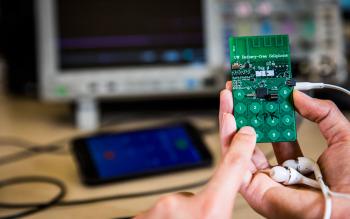A mobile phone that requires no batteries is an interesting proposition. While not a smartphone, this device could prove to be extremely useful for some, and mark the origin of a battery-less mobile tech industry. Researchers at the University of Washington (UW) have created a battery-free cellphone which operates using energy harvested from ambient radio signals and light. The device only requires 3.5 microwatts for continuous operation and was demonstrated making Skype calls.
The prototype mobile phone from the UW is said to use off the shelf parts. Its unique capabilities stem more from how the hardware is used than the particular component choices. "To achieve the really, really low power consumption that you need to run a phone by harvesting energy from the environment, we had to fundamentally rethink how these devices are designed," explained UW associate professor Shyam Gollakota.
An example of the lateral thinking applied is that the converting of analogue signals, that convey sound into digital data and vice-versa, is simply bypassed. No A/D conversion takes place in the 'phone' as the tiny vibrations in a phone's microphone or speaker that occur when a person is talking into a phone or listening to a call are communicated as-is via analogue radio antenna to a base station.
The tiny battery-less mobile phone was tested in transmitting voice, data, and button presses. Using Skype the phone could make and receive voice calls and even put callers on hold. Calls need a constant connection to the base station, unlike some IoT devices might, so keeping power flow for the call duration was a particular challenge.
Currently this mobile phone requires a custom base station to transmit and receive the radio signals. However, the tech could be integrated into standard cellular network infrastructure, or into home Wi-Fi routers that are so ubiquitous. In tests the researchers found their mobile phone was functional within 31ft of the base station relying only on energy harvesting ambient radio signals. If the phone design included a tiny solar cell, roughly the size of a grain of rice, the device was able to communicate with a base station that was up to 50ft away.
Work on this project continues as the UW researchers are looking into adding an e-Ink screen to the device, and even implementing streaming video capbilities.







